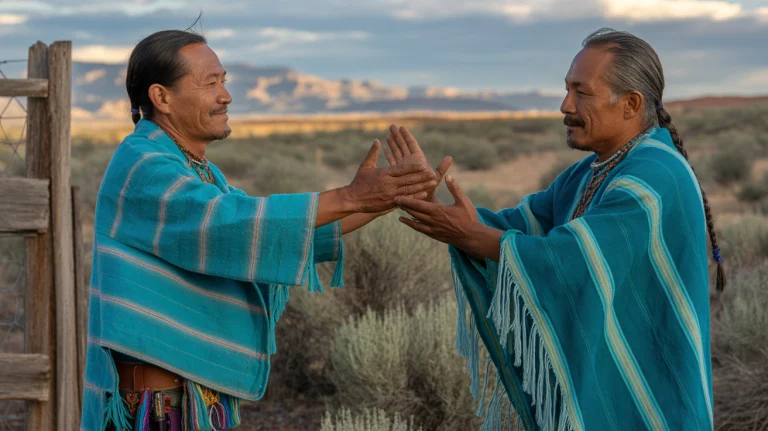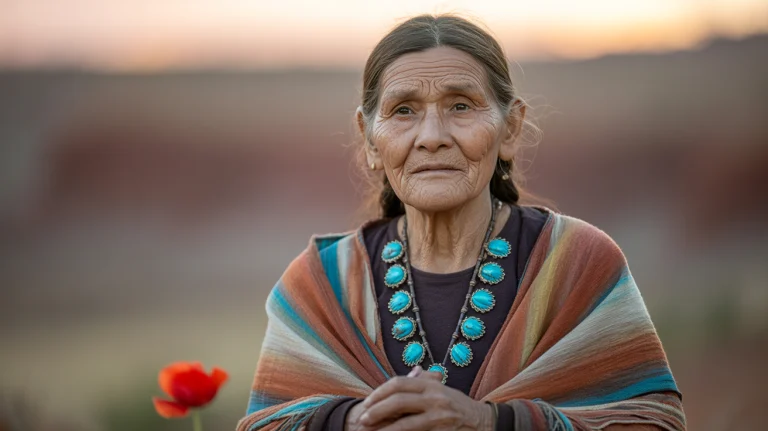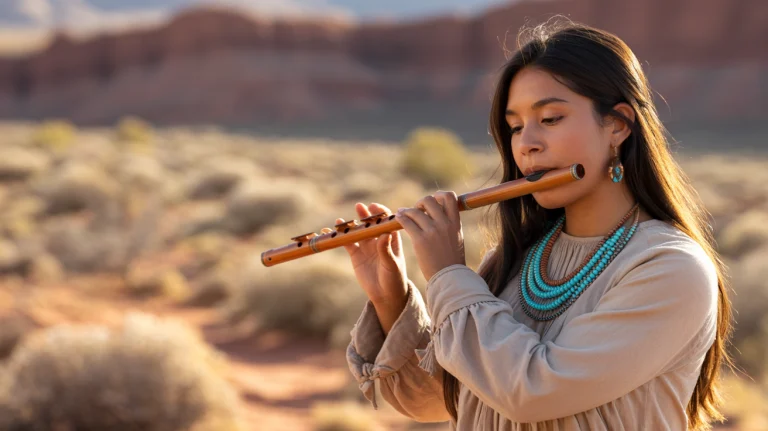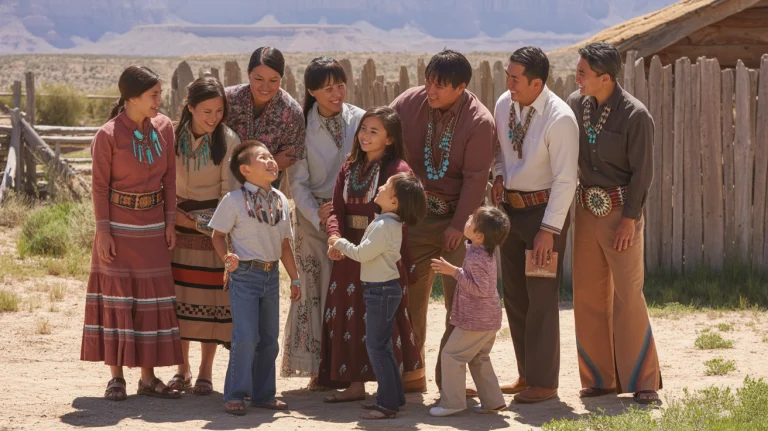The haunting, soulful melody of a Native American flute carries more than just beautiful music—it carries centuries of cultural tradition, spiritual significance, and healing power.
This iconic instrument has captivated listeners worldwide, transcending its indigenous origins to become a beloved tool for meditation, therapy, and artistic expression.
Whether you’re drawn to the Native American flute for its therapeutic qualities, its rich cultural heritage, or simply the enchanting sounds it produces, this comprehensive guide will take you on a journey through its fascinating history, construction, and modern applications.
From traditional tribal ceremonies to contemporary healing music, the Native American flute continues to touch hearts and souls across the globe.
In this article, we’ll explore everything you need to know about this remarkable instrument: its ancient origins, cultural importance, how it’s made, different playing styles, famous musicians, and how you can begin your own musical journey with this spiritual woodwind instrument.
What Is the Native American Flute?
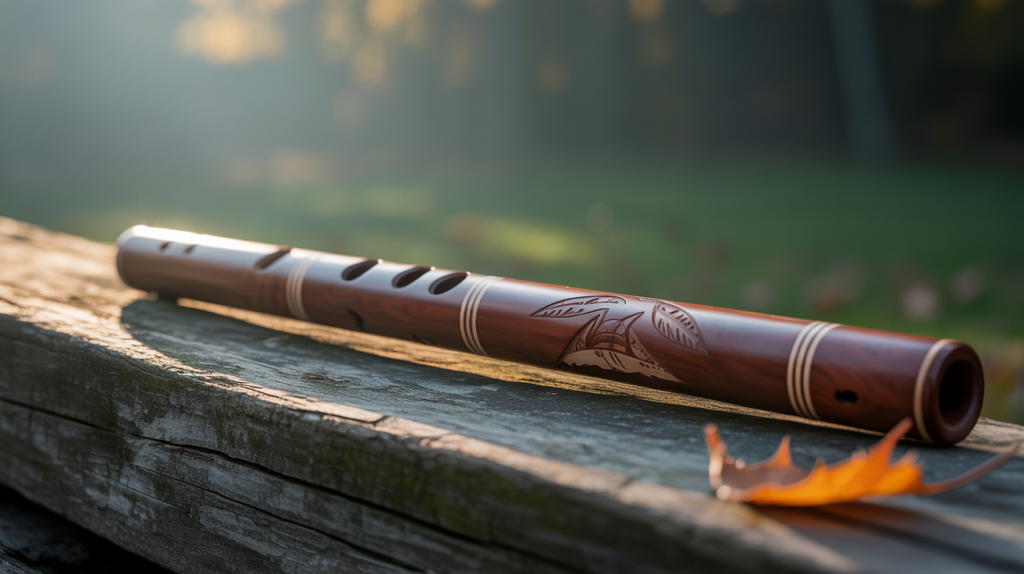
The Native American flute is a distinctive woodwind instrument that stands apart from modern Western flutes in both construction and sound.
Unlike the metal transverse flutes common in orchestras, the Native American flute is typically made from wood and played vertically, creating its characteristic warm, breathy tone that seems to echo the natural world.
This indigenous flute music instrument features a unique two-chamber design that sets it apart from other wind instruments worldwide.
The flute consists of a slow air chamber and a sound chamber, connected by a mechanism that creates its signature sound.
A removable block, often called a “bird” or “fetish,” sits on top of the flute and directs airflow to create the instrument’s distinctive voice.
Types of Native American Flutes
The world of Native American flutes encompasses several distinct styles, each with its own characteristics and regional origins:
Plains Style Flutes are perhaps the most recognized type, featuring the classic two-chamber design with an external block.
These flutes typically have five or six finger holes and produce the deep, meditative tones most people associate with Native American flute music.
Woodlands Style Flutes represent an older tradition, often featuring simpler construction with fewer holes and a more primitive appearance. These instruments connect us directly to the earliest forms of indigenous flute music.
Drone Flutes incorporate multiple chambers that can produce continuous background tones while the player creates melodies on the primary chamber, adding rich harmonic depth to performances.
The Native American flute instrument differs significantly from other indigenous wind instruments found across the Americas.
While similar flutes exist in various Native cultures, the specific design and playing techniques of the North American version have evolved into something truly unique in the world of traditional music.
History of the Native American Flute

The history of the Native American flute stretches back thousands of years, with archaeological evidence suggesting that indigenous peoples of North America have been crafting and playing flutes for over 1,500 years.
Some artifacts and cave paintings indicate that primitive flutes may have existed even earlier, making this one of the oldest continuously used musical instruments on the continent.
Ancient Origins and Early Evidence
The earliest physical evidence of Native American flutes dates back to around 620 CE, discovered in archaeological sites throughout the American Southwest. These ancient instruments were often made from bird bones, hollowed wood, or even clay, demonstrating the resourcefulness and musical creativity of indigenous peoples.
Different tribes developed their own unique styles and construction methods over the centuries. The Anasazi people of the Southwest created flutes from turkey bones and wood, while Plains tribes favored longer flutes made from river cane and cedar.
Each regional variation reflected the available materials and cultural preferences of the communities that crafted them.
Tribal Traditions and Cultural Evolution
Throughout Native American history, the flute played crucial roles in tribal life that extended far beyond entertainment.
Among many Plains tribes, young men used Native American flute courtship music to woo potential partners, believing that the instrument’s voice could express emotions that words could not capture.
The Lakota people tell beautiful stories about the flute’s origins, including legends of woodpeckers teaching humans how to make music from hollow wood.
These oral traditions have preserved not only the techniques of flute making but also the spiritual and cultural significance attached to the instrument.
Modern Rediscovery and Global Spread
The Native American flute experienced a remarkable renaissance in the 20th century, largely thanks to the efforts of dedicated musicians and cultural preservationists.
After decades of cultural suppression, indigenous artists began reclaiming and revitalizing their musical traditions, bringing the flute back from near extinction.
This revival gained momentum in the 1960s and 1970s, coinciding with increased interest in Native American culture and spirituality.
The emergence of the New Age movement in the 1980s further propelled the flute into mainstream consciousness, as people sought meditative and healing music that connected them to nature and spirituality.
Cultural and Spiritual Significance

The Native American flute carries profound spiritual meaning that goes far beyond its role as a musical instrument.
In many indigenous traditions, the flute serves as a bridge between the physical and spiritual worlds, its voice believed to carry prayers, heal emotional wounds, and connect players to the natural environment.
Sacred Ceremonies and Healing Rituals
Traditional Native American ceremonies often incorporate flute music as a powerful tool for healing and spiritual transformation.
The instrument’s soothing tones are thought to calm the mind, reduce stress, and promote emotional healing—beliefs that modern science has begun to validate through research into sound therapy and music’s therapeutic effects.
Many tribes used Native American flute healing music during vision quests, sweat lodge ceremonies, and other sacred rituals.
The flute’s voice was believed to guide participants into deeper states of meditation and spiritual awareness, helping them connect with their inner wisdom and the greater cosmos.
Symbolism and Natural Connection
The Native American flute embodies powerful symbolism related to nature, breath, and the life force itself.
The act of breathing life into the instrument mirrors the sacred breath that gives life to all beings, making the flute a powerful metaphor for creation and spiritual connection.
Many traditional flutes feature decorative elements that reflect this natural symbolism—carved birds, painted animals, or wrapped leather that honors the creatures whose sacrifice made the instrument possible. The wood itself is often blessed and treated as a living entity deserving of respect and care.
Courtship and Social Traditions
One of the most romanticized aspects of Native American flute history involves its use in courtship rituals.
Young men would often play flute music outside the homes of potential partners, using the instrument’s expressive voice to communicate feelings that social customs prevented them from expressing directly.
These courtship songs, passed down through generations, became an integral part of tribal musical traditions.
The melodies were often simple enough for beginners to learn but contained subtle variations that allowed skilled players to demonstrate their musical abilities and emotional depth.
How Native American Flutes Are Made
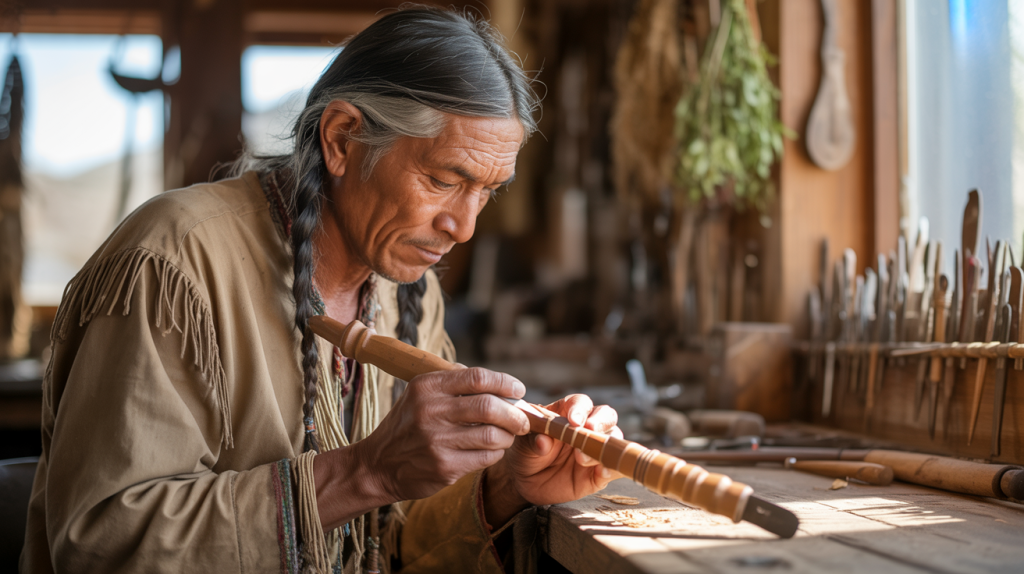
The construction of a Native American flute is both an art and a science, requiring skilled craftsmanship and deep understanding of acoustics, wood properties, and traditional techniques.
Modern flute makers blend ancient wisdom with contemporary innovations to create instruments that honor tradition while meeting the needs of today’s musicians.
Traditional Materials and Selection
Traditionally, Native American flute construction relied on materials readily available in the natural environment.
Cedar was and remains one of the most popular choices due to its resonant qualities, natural resistance to decay, and spiritual significance in many tribal traditions.
The wood’s straight grain and aromatic properties make it ideal for creating instruments with warm, rich tones.
River cane, bamboo, and other hardwoods like walnut, cherry, and maple also serve as excellent flute materials.
Each wood type imparts its own tonal characteristics—cedar tends to produce softer, more breathy sounds, while hardwoods like walnut create brighter, more focused tones.
The selection process involves more than just choosing attractive wood. Master craftsmen look for pieces with straight grain, minimal knots, and the right density to produce optimal sound quality.
Many traditional makers also consider the spiritual aspects of their material choices, selecting wood from trees that have fallen naturally or been harvested with appropriate ceremonies.
Construction Process and Techniques
Creating an authentic Native American flute requires numerous precise steps, each critical to the instrument’s final sound quality and playability.
The process begins with splitting the chosen wood into two halves, which are then carefully hollowed out to create the instrument’s chambers.
The bore—the internal cavity where air travels—must be precisely shaped to achieve proper tuning and tone quality.
Traditional makers used simple tools like heated metal rods and scrapers to hollow and shape the bore, a process that required considerable skill and patience.
One of the most critical aspects of Native American flute construction is creating the sound mechanism that gives the instrument its distinctive voice.
This involves carefully shaping the flue (the channel that directs air), the splitting edge (where the air stream breaks to create sound), and the sound hole placement.
Modern Innovations and Craftsmanship
Contemporary flute makers have refined traditional techniques while introducing modern innovations that improve consistency and playability.
Computer-aided design tools help optimize bore shapes and hole placement, while precision machinery ensures more consistent results than purely hand-crafted instruments.
Many modern makers still honor traditional methods by hand-finishing their flutes and incorporating ceremonial elements into their construction process.
The combination of traditional wisdom and modern precision has led to a golden age of flute making, with instruments available in a wider range of keys, woods, and artistic styles than ever before.
Native American Flute Music and Styles
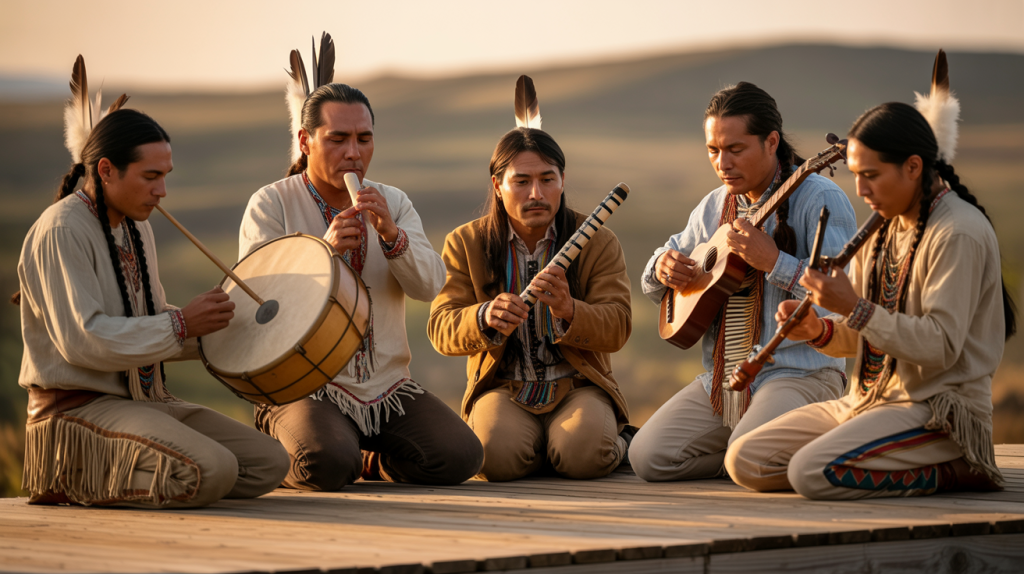
The world of Native American flute music encompasses a rich tapestry of traditional songs, contemporary compositions, and fusion styles that bridge ancient and modern musical expressions.
From ceremonial chants passed down through generations to innovative jazz fusion pieces, the flute’s versatile voice adapts beautifully to numerous musical contexts.
Traditional Songs and Tribal Variations
Each Native American tribe developed its own repertoire of traditional flute songs, many of which remain closely guarded cultural treasures.
These pieces often reflect the natural environment, seasonal cycles, and spiritual beliefs of their originating communities.
Lakota flute songs frequently imitate the calls of birds and animals, while Pueblo traditions include pieces designed for specific ceremonies and seasonal celebrations.
Many of these traditional Native American flute songs feature pentatonic scales that create their characteristic otherworldly sound, avoiding the half-steps common in Western music.
The scales used in Native American flute music often correspond to the instrument’s natural harmonic series, making them intuitive to play even for beginners.
This accessibility has contributed to the flute’s popularity among novice musicians seeking a meditative musical practice.
Ceremonial and Healing Applications
Native American flute healing music represents one of the instrument’s most important traditional applications.
The flute’s soothing tones have been used for centuries to promote emotional healing, reduce stress, and facilitate spiritual transformation.
In powwow settings, flute music often accompanies dancing and singing, providing melodic support for community celebrations and cultural preservation activities.
The instrument’s ability to cut through ambient noise while maintaining its peaceful character makes it ideal for outdoor ceremonial use.
Sound therapy practitioners increasingly incorporate Native American flute meditation music into their healing work, recognizing the instrument’s power to induce relaxation and promote wellness.
Scientific studies have begun to validate what indigenous peoples have known for centuries—that flute music can lower blood pressure, reduce anxiety, and promote healing.
Contemporary and Fusion Genres
The versatility of the Native American flute has led to its incorporation into numerous contemporary musical genres.
New Age artists have embraced the instrument for its meditative qualities, creating ambient soundscapes that blend traditional flute voices with modern synthesizers and natural sound recordings.
Jazz musicians have discovered the flute’s expressive potential for improvisation, while world music artists combine Native American flute traditions with other indigenous instruments to create compelling fusion pieces.
The instrument’s unique tonal qualities make it particularly effective in film soundtracks, where it can evoke everything from spiritual transcendence to connection with the natural world.
Contemporary Native American flute players often blend traditional songs with original compositions, creating music that honors cultural heritage while speaking to modern audiences.
This evolution ensures that the flute tradition remains vibrant and relevant while preserving its essential spiritual and cultural significance.
Learning to Play the Native American Flute
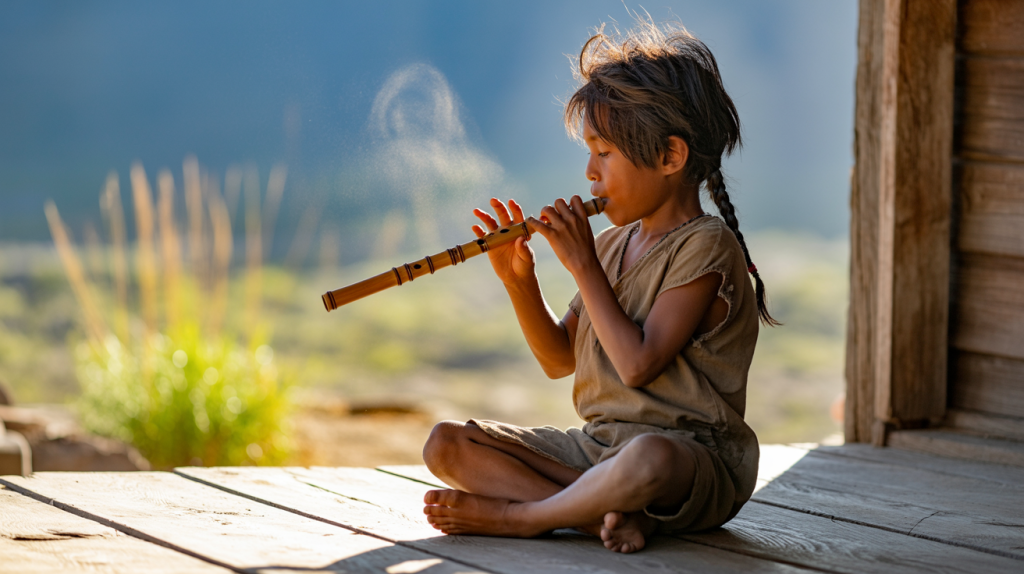
Learning to play the Native American flute offers a uniquely accessible and rewarding musical journey.
Unlike many instruments that require years of study to produce pleasant sounds, the Native American flute can create beautiful music even in beginner hands, making it an ideal choice for those seeking a meditative musical practice.
Getting Started: Basic Techniques
The foundation of Native American flute playing begins with proper breathing and posture. Unlike traditional Western flutes, the Native American flute is held vertically, similar to a recorder, which creates a natural, comfortable playing position that supports proper breath control.
Breathing for flute playing emphasizes slow, steady airflow rather than forced breath support. The instrument responds beautifully to gentle, consistent air pressure, producing its characteristic warm, breathy tone that mirrors the natural rhythm of relaxed breathing.
Fingering and Scale Patterns
Most Native American flutes feature five or six finger holes arranged in a pattern that naturally creates pentatonic scales.
This design makes it nearly impossible to play “wrong” notes, as the available pitches naturally complement each other in pleasing harmonic relationships.
Beginning students typically start with simple scale exercises, learning to cover and uncover holes smoothly while maintaining steady breath support.
The native American flute scale patterns follow logical progressions that make melodic playing intuitive, even for those without formal musical training.
Common Mistakes and How to Avoid Them
New players often make the mistake of blowing too hard, which can cause the flute to overblow or produce harsh tones.
The Native American flute responds best to gentle, steady airflow that allows its natural voice to emerge clearly.
Another common error involves incorrect finger placement, which can cause air leaks and unclear notes.
Proper technique involves sealing the holes completely with the soft pads of the fingertips while maintaining relaxed hand positions that allow for smooth transitions between notes.
Learning Resources and Practice Methods
The abundance of Native American flute tutorials available online has made learning more accessible than ever before.
Video lessons allow students to observe proper technique and hear correct tone production, while online communities provide support and encouragement for developing players.
Many successful students combine online resources with occasional in-person instruction, taking advantage of workshops and festivals where they can learn directly from experienced players.
This blended approach provides both the convenience of self-paced learning and the invaluable feedback that comes from direct interaction with skilled teachers.
Famous Native American Flute Players

The global popularity of Native American flute music owes much to pioneering artists who have dedicated their lives to preserving, developing, and sharing this beautiful musical tradition.
These musicians have not only mastered the technical aspects of flute playing but have also served as cultural ambassadors, introducing worldwide audiences to the spiritual and healing power of indigenous music.
R. Carlos Nakai: The Pioneer
R. Carlos Nakai stands as perhaps the most influential figure in modern Native American flute music.
A member of the Navajo and Ute tribes, Nakai has released more than 50 albums and has been instrumental in bringing the flute to mainstream audiences while maintaining deep respect for its cultural origins.
Nakai’s approach combines traditional playing techniques with contemporary musical sensibilities, creating compositions that honor ancestral traditions while speaking to modern listeners.
His album “Canyon Trilogy” became the first Native American recording to achieve platinum status, proving the commercial viability of authentic indigenous music.
Beyond his recording career, Nakai has been an educator and cultural preservationist, working to ensure that traditional flute knowledge is passed on to future generations.
His workshops and masterclasses have inspired countless musicians to explore the Native American flute tradition with proper respect and understanding.
Mary Youngblood: Breaking Barriers
Mary Youngblood made history as the first Native American woman to win a Grammy Award for her flute music, earning recognition for her albums “Beneath the Raven Moon” and “Dance with the Wind.”
Her success has opened doors for other indigenous women musicians and has demonstrated the universal appeal of authentic Native American flute music.
Youngblood’s playing style combines technical excellence with deep emotional expression, creating music that ranges from intimate solo pieces to elaborate orchestral collaborations.
Her work often incorporates elements from her Seminole and Aleut heritage, adding unique flavors to the broader Native American flute tradition.
Contemporary Artists and Innovators
The current generation of Native American flute players continues to expand the instrument’s possibilities while honoring its traditions.
Artists like Kevin Locke, Douglas Blue Feather, and Gary Stroutsos have each contributed unique voices to the tradition, exploring everything from traditional tribal music to jazz fusion and world music collaborations.
These contemporary native American flute players often use their platforms to educate audiences about indigenous culture and environmental issues, demonstrating how music can serve as a vehicle for cultural preservation and social awareness. Their innovations ensure that the flute tradition remains vibrant and relevant for future generations.
Native American Flute in Modern Culture

The integration of Native American flute music into contemporary culture represents both an opportunity for cultural appreciation and a responsibility to approach the tradition with appropriate respect.
From yoga studios to hospital healing rooms, the flute’s therapeutic voice has found new applications while maintaining its essential spiritual character.
Film and Media Applications
Hollywood has embraced the Native American flute for its ability to evoke powerful emotions and create atmospheric soundscapes.
The instrument frequently appears in film soundtracks that deal with themes of nature, spirituality, and cultural identity, although this usage sometimes raises concerns about stereotypical representation.
More thoughtful applications of flute music in media involve collaboration with Native artists who can ensure authentic representation and appropriate cultural context.
These partnerships create opportunities for genuine cultural education while providing Native musicians with platforms to share their traditions.
Wellness and Therapeutic Applications
The use of Native American flute sound therapy has expanded significantly as healthcare providers recognize music’s healing potential.
Hospitals, counseling centers, and alternative therapy practices increasingly incorporate flute music into their treatment protocols, taking advantage of its proven ability to reduce stress and promote relaxation.
Research has shown that listening to Native American flute meditation music can lower cortisol levels, reduce blood pressure, and improve sleep quality.
These findings provide scientific validation for therapeutic practices that indigenous communities have used for centuries.
Global Adoption and Cultural Bridge
The worldwide popularity of Native American flute music reflects humanity’s universal need for spiritual connection and natural harmony.
Musicians from diverse cultural backgrounds have adopted the instrument, often blending it with their own musical traditions to create unique fusion styles.
This global adoption carries both opportunities and responsibilities. When approached with proper respect and cultural understanding, cross-cultural musical exchange can build bridges between communities and promote mutual appreciation.
However, this adoption mustn’t lead to cultural appropriation or misrepresentation of Native traditions.
Buying a Native American Flute

Selecting your first Native American flute is an exciting journey that requires consideration of multiple factors including budget, musical goals, and ethical considerations.
The market offers instruments ranging from affordable beginner models to museum-quality pieces crafted by master artisans.
Beginner vs. Professional Instruments
For newcomers to Native American flute music, beginner-friendly instruments typically offer the best value and learning experience.
These flutes usually feature simple five-hole designs in popular keys like A or G, providing a comfortable playing range and reliable tuning that supports skill development.
Professional-quality flutes incorporate premium materials, precise tuning, and superior craftsmanship that enhance both sound quality and playability.
While these instruments represent significant investments, they often provide decades of musical enjoyment and can even appreciate when crafted by renowned makers.
Key Selection and Tuning Considerations
The key of a Native American flute determines its pitch range and tonal character. Lower-pitched flutes (like those in G or A) produce deeper, more meditative tones that many find ideal for relaxation and healing music.
Higher-pitched flutes (in keys like D or E) offer brighter sounds that cut through ambient noise more effectively.
Many players eventually acquire multiple flutes in different keys, allowing them to match their instrument choice to their mood, musical goals, or performance setting. This approach also enables exploration of different scales and tonal colors that each key provides.
Authentic Makers and Trusted Sources
When purchasing a Native American flute, it’s crucial to support authentic Native artisans and avoid mass-produced imitations that may lack both quality and cultural authenticity.
Reputable Native American flute makers often provide detailed information about their cultural background, construction methods, and the materials used in their instruments.
Established makers typically offer warranties and ongoing support for their instruments, including maintenance advice and repair services.
This relationship between maker and player helps ensure that your flute will provide years of musical enjoyment while supporting the continuation of traditional crafts.
Avoiding Cultural Appropriation in Purchasing
Responsible flute ownership involves understanding and respecting the cultural significance of the instrument.
This means purchasing from Native artisans when possible, learning about the cultural context of the music you play, and avoiding the use of sacred songs or ceremonial music in inappropriate contexts.
Many Native flute makers are happy to educate purchasers about proper care and culturally appropriate use of their instruments.
This guidance helps ensure that your musical journey honors the traditions that created this beautiful art form.
Preservation and Respect for Tradition
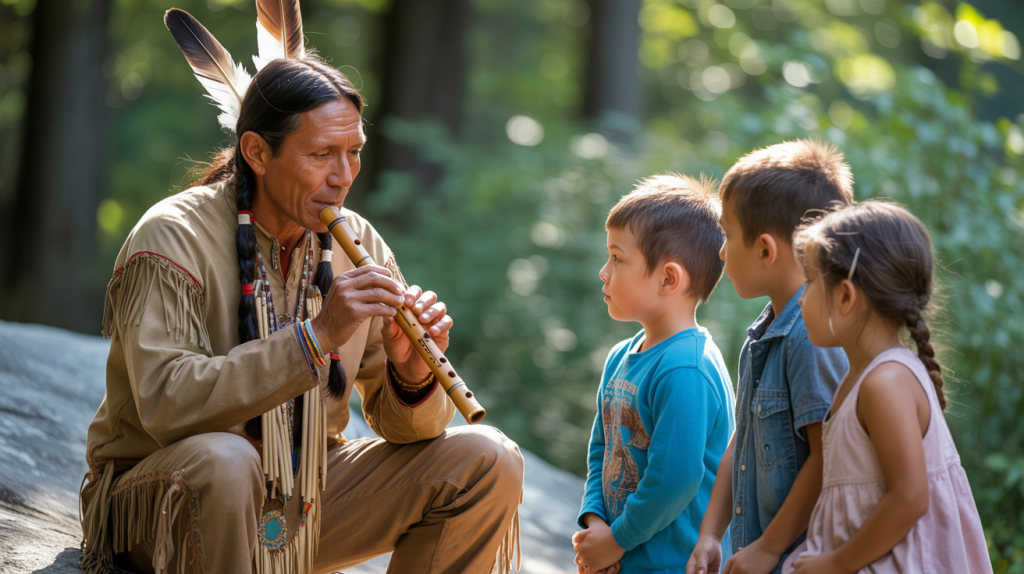
The growing popularity of Native American flute music creates both opportunities for cultural preservation and risks of cultural dilution or misappropriation.
Maintaining the authentic spirit and cultural significance of this tradition requires conscious effort from players, teachers, and the broader music community.
Supporting Native Communities
One of the most effective ways to honor Native American flute traditions is by directly supporting Native communities and artisans.
This includes purchasing instruments from Native makers, attending performances by Native artists, and contributing to organizations that preserve indigenous musical traditions.
Many tribes and cultural centers offer educational programs that teach both flute playing and cultural context, providing authentic learning experiences that benefit both students and Native communities.
These programs often represent the most reliable sources for accurate historical and cultural information about the flute tradition.
Cultural Education and Awareness
Responsible engagement with Native American flute music requires ongoing education about indigenous history, culture, and contemporary issues.
This education helps players understand the broader context of their musical practice and develop appropriate respect for the traditions they’re exploring.
Many excellent resources exist for learning about Native American culture, including books, documentaries, and educational websites created by Native scholars and cultural practitioners. This learning process should be viewed as an ongoing journey rather than a one-time requirement.
Organizations and Cultural Centers
Numerous organizations work to preserve and promote authentic Native American musical traditions.
The Native American Music Association, various tribal cultural centers, and educational institutions offer resources for both Native and non-Native musicians interested in learning about flute traditions.
These organizations often sponsor festivals, workshops, and educational programs that provide opportunities for authentic cultural exchange and learning.
Supporting these initiatives helps ensure that traditional knowledge continues to be passed on to future generations.
Conclusion
The Native American flute stands as a testament to the enduring power of music to heal, inspire, and connect us to something greater than ourselves.
From its ancient origins in tribal ceremonies to its modern applications in therapy and meditation, this remarkable instrument continues to touch hearts and souls across cultural boundaries.
Whether you’re drawn to the Native American flute for its meditative qualities, its rich cultural heritage, or simply the beautiful music it creates, approaching this tradition with respect and understanding enhances both your musical journey and the preservation of indigenous cultural treasures.
As you explore the world of Native American flute music, remember that each note carries the wisdom of generations, each melody connects you to the natural world, and each breath through the instrument honors the spiritual traditions that created this timeless art form.
The flute’s voice calls us to slow down, listen deeply, and reconnect with the essential rhythms of life that our modern world often obscures.
Consider beginning your own musical journey with this ancient yet ever-relevant instrument. Whether you choose to learn traditional songs, create your own meditative compositions, or simply enjoy listening to the masters who have devoted their lives to this tradition, the Native American flute offers a pathway to inner peace, cultural understanding, and musical expression that few instruments can match.
Support Native artisans, learn with respect for the tradition’s origins, and allow the flute’s ancient voice to guide you toward a deeper connection with music, nature, and the timeless human need for beauty and spiritual expression.
Frequently Asked Questions
What is the Native American flute used for?
The Native American flute serves multiple purposes including meditation, healing therapy, ceremonial music, courtship rituals, and personal musical expression.
Traditionally used in Native American ceremonies and healing practices, today it’s also popular for stress relief, yoga, sound therapy, and contemporary music composition.
Which tribes used the Native American flute?
Many Native American tribes developed flute traditions, including the Lakota, Pueblo, Anasazi, Cherokee, Navajo, and various Plains and Woodland tribes.
Each tribe created unique styles and construction methods reflecting their cultural preferences and available materials, contributing to the rich diversity of Native American flute traditions.
What key is the Native American flute in?
Native American flutes are made in various keys, with the most common being A, G, F#, and D. The key determines the flute’s pitch range and tonal character.
Lower keys like G and A produce deeper, more meditative sounds, while higher keys like D and E create brighter, more penetrating tones.
How hard is it to learn the Native American flute?
The Native American flute is considered one of the easier instruments to learn, as it produces beautiful sounds even for beginners.
The pentatonic scale design makes it nearly impossible to play “wrong” notes. Most people can play simple melodies within their first session, though mastering advanced techniques and traditional songs requires ongoing practice and cultural study.
What makes a Native American flute authentic?
Authentic Native American flutes are typically made by Native artisans using traditional construction methods and materials like cedar, walnut, or river cane.
They feature the characteristic two-chamber design with a removable block and produce the distinctive warm, breathy tone associated with traditional Native American music. Purchasing from verified Native makers ensures authenticity and supports indigenous communities.
Source: The Breckenridge Flute – Arkansas Archeological Survey (University of Arkansas Museum)
Related Article: Native American Music



